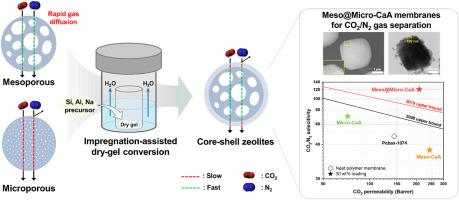浸渍辅助合成分级核壳型CaA沸石填料以增强混合基质膜中CO2/N2的分离
IF 9
1区 工程技术
Q1 ENGINEERING, CHEMICAL
引用次数: 0
摘要
在这项研究中,我们报告了一种通过浸渍辅助干凝胶转化法合成层次化lta型核壳沸石(Meso@Micro-CaA)的新策略。由此产生的结构具有介孔CaA核心,以促进快速气体扩散,包裹在微孔CaA外壳中,提供分子筛选功能并防止聚合物链侵入。由于薄微孔壳的扩散阻力最小,这种结构可以在不牺牲渗透率的情况下实现高CO2/N2选择性。与传统的水热合成相比,干凝胶转化工艺具有简化操作、抑制不需要的成核、形成均匀的壳、减少水消耗和缩短合成时间等关键优势。合成的Meso@Micro-CaA具有明确的分层孔隙结构,具有相互连接的介孔(~ 12 nm)和微孔(~ 0.5 nm),从而获得高表面积和增强的CO2吸附能力。当以30 wt%的负载加入到Pebax®1074基混合基质膜(MMMs)中时,Meso@Micro-CaA的CO2渗透率为209 Barrer, CO2/N2选择性为121.3,超过了2019年的上限。这些改进归功于分层孔隙度和核壳设计的协同效应。这项工作证明了分层核壳沸石作为高性能膜基气体分离的下一代填料的潜力,并提出了一个适用于其他沸石拓扑结构的通用合成平台。本文章由计算机程序翻译,如有差异,请以英文原文为准。

Hierarchical core–shell CaA zeolite fillers via impregnation-assisted synthesis for enhanced CO2/N2 separation in mixed-matrix membranes
In this study, we report a novel strategy for synthesizing hierarchical LTA-type core–shell zeolites (Meso@Micro-CaA) via an impregnation-assisted dry-gel conversion method. The resulting structure features a mesoporous CaA core to promote rapid gas diffusion, encased in a microporous CaA shell that provides molecular sieving functionality and prevents polymer chain intrusion. This architecture enables high CO2/N2 selectivity without sacrificing permeability, owing to minimized diffusion resistance from the thin microporous shell. The dry-gel conversion process offers key advantages over conventional hydrothermal synthesis, including simplified operation, suppression of unwanted nucleation, uniform shell formation, reduced water consumption, and shorter synthesis time. The synthesized Meso@Micro-CaA exhibits a well-defined hierarchical pore structure with interconnected mesopores (∼12 nm) and micropores (∼0.5 nm), resulting in a high surface area and enhanced CO2 adsorption capacity. When incorporated into Pebax® 1074-based mixed-matrix membranes (MMMs) at 30 wt% loading, Meso@Micro-CaA achieved a CO2 permeability of 209 Barrer and a CO2/N2 selectivity of 121.3, exceeding the 2019 upper bound. These improvements are attributed to the synergistic effects of hierarchical porosity and the core–shell design. This work demonstrates the potential of hierarchical core–shell zeolites as next-generation fillers for high-performance membrane-based gas separation and presents a versatile synthesis platform applicable to other zeolite topologies.
求助全文
通过发布文献求助,成功后即可免费获取论文全文。
去求助
来源期刊

Journal of Membrane Science
工程技术-高分子科学
CiteScore
17.10
自引率
17.90%
发文量
1031
审稿时长
2.5 months
期刊介绍:
The Journal of Membrane Science is a publication that focuses on membrane systems and is aimed at academic and industrial chemists, chemical engineers, materials scientists, and membranologists. It publishes original research and reviews on various aspects of membrane transport, membrane formation/structure, fouling, module/process design, and processes/applications. The journal primarily focuses on the structure, function, and performance of non-biological membranes but also includes papers that relate to biological membranes. The Journal of Membrane Science publishes Full Text Papers, State-of-the-Art Reviews, Letters to the Editor, and Perspectives.
 求助内容:
求助内容: 应助结果提醒方式:
应助结果提醒方式:


